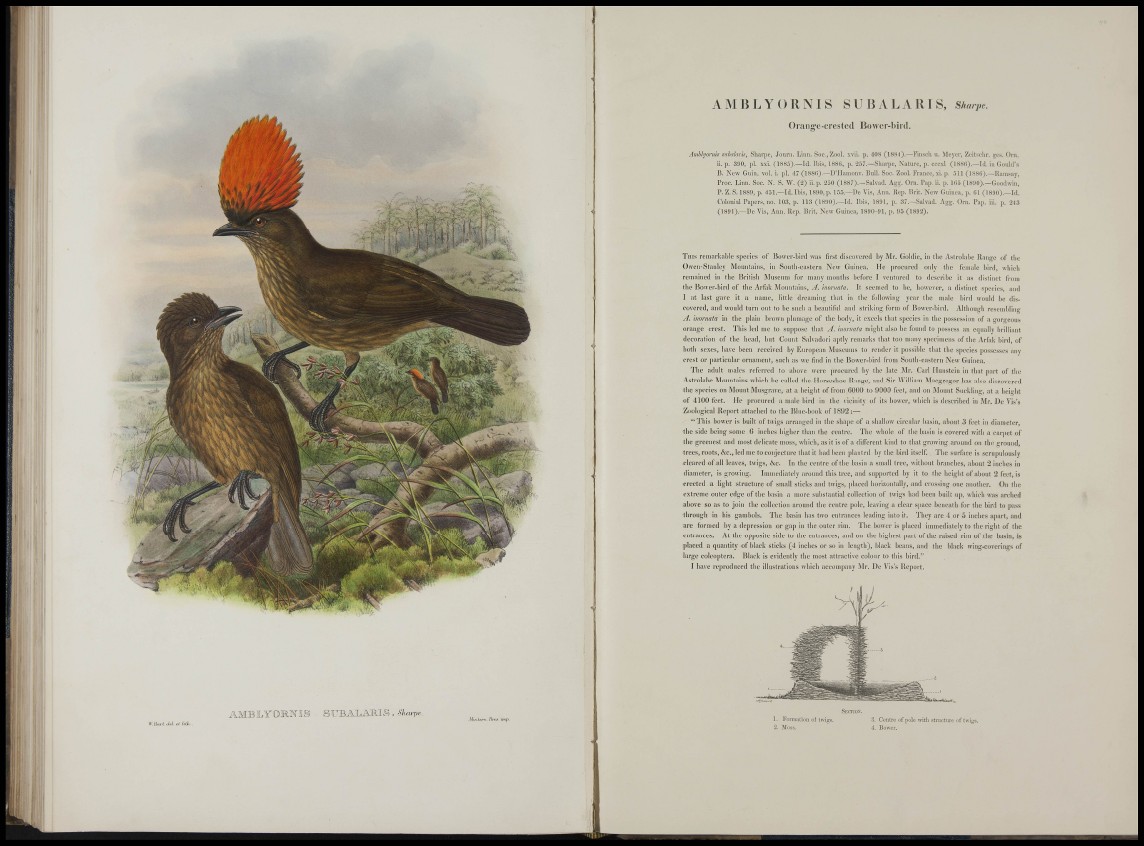
I
ir
I í¡: I
J Ñiarpe.
If. /(«/•( pí í<U , . V/i/i.íwrij /Íí'iw! im^.
A M B L Y () R N I S S U B A L A R 1 S , Shorpe.
O r a n " ' c - e r e s t e d Bower-bird.
Amhlyoriiis suhalaris, Sharpe, Jourii. Linn. Soc.,Zool. xvii. p. 408 (1884).—Finsch u. iNieyer, Ztitschr. ges. Orri.
ii. p. 390, Jil. xxi. ( 1S8 j ) .—Id. Ibis, 188(i, p. 257.—Sliarpe, Nature, p. cccxl (1880).—Id. in Gould's
B . Now Guin. vol. i. jil. 47 (188(i).—U'lliimonv. Bull. Soc. Zool. Franco, xi. p. 311 (lS8(i).—Ramsay,
P r o c . Linn. Soc. N. S. W . (2) ii.p. 230 (1887).—Salvad. Agg. Orn. I'ap ii. p. 105 (18!)0).—Goodwin,
P . Z. S . 188!), p. 4 5 1 .—Id. Ibis, 1890, p. 155.—Do Vis, Ann. Kep. Brit. New Guinea, p. 01 (18!)0).—Id.
Colonial Papers, no. 103, p. 113 (181)0).—Id. Ibis, 18!)1, p. 37.—Salvad. Agg. Orn. Pap. iii. p. 243
( 1 8 9 1 ) . — D o Vis, Ann. Kep. Brit. New Guinea, 1890-91, p. 95 (1892).
THIS remarkalile species of Bower-biril was first ciiscoverod by Mr. Goldie, in tlie Astrolid)e liani'c of the
Oweii-Staiilev Mountains, in South-eustci'u New Guinea. He procured only the female bird, wbicli
remained in the Britisli Museum for many mouths before I ventured to (leseribe It as distinct from
the Bowor-bird of the Arfak Mountains, /J. hiornata. It seemed to be, however, a distinct -species, aud
I at last gave it a name, little dreaming that In the followlntf year the male bird would be discovered,
and would turn out to be such a beautifnl and striking form of Bower-bird. Althongh resembling
A. inornata in the ])lain brown plumage of the body, It excels that species in the possession of a gorgeous
orange crest. This led ine to su¡)j)ose that A. inornata nilglit also be found to possess an equally bi-|lllant
decoration of the head, but Count Salvador! aptly remarks that too many specimens of the Arfak bird, of
both sexes, have been received by European Museums to render it possible that the species |>ossesses any
crest or particular ornament, such as WT find in the Boiver-bird from South-eastern New Guinea.
The adnlt males referred to above were procured by the late Mr. Carl Ilunstelu in that part of the
Astrolabe Mountains which he called the Horseshoe Range, and Sir William Macgregor has also discovered
the species on MouLit Mnsgrave, at a height of from 0000 to 9000 feet, and on Mount Suckling, at a height
of 4100 feet. He procured a m;dc bird in the vicinity of Its bowei-, which Is described In Mr. De Vis's
Zoological Report attached to the ]5lne-book of 1802:—
" T h i s bovver Is built of tivigs arranged in the shape of a shallow circular basin, about Ü feet In diameter,
the side being some (i Inches higher than the centj-e. The whole of the basin is covei'cd with a carpet of
the greenest and most delicate moss, w hich, as it is of a dllferent kind to that growing aromul on the ground,
trees, roots, ¿^'c., led me to conjecture that It had been planted by the bird Itself. The surface Is scrupulously
clcared of all leaves, twigs, &c. In the centre of the basin a small tj-ee, without bi-anches, about 2 Inches in
díamete)-, is growing. Immediately ai-oiind this tree, and supported by it to the heiglit of about 2 feet, is
o-ected a light structure of small sticks and twigs, placed horizontally, aud crossing one anotbei-. Oil the
extreme outer edge of the basin a more substantial collection of twigs had been built iij), which was arched
above so as to join the collection around the centre pole, leaving a clear space beneath for the bird to pass
through in his gambols. The basin has two entrances leading into it. They are 4 or 5 Inches apart, and
are formed by a depression or gap In the outer rini. The bower is placed Immediately to the right of the
entrances. At the opposite side to the enti'auces, and on the highest part of the raised rim of the basin, is
placed a quantity of black sticks (4 inches or so in length), black beans, and the black wiug-coverlngs of
large coleoptera. Black Is evidently the most atti-actlve colour to this bird."
I have rcjiroduced the Illustrations which accompany Mr. De Vis's Report.
SECTIOX.
1. Formation of twigs.
2. Moss.
3. Centre of pole with structiu-e of twigs.
4. Bower.